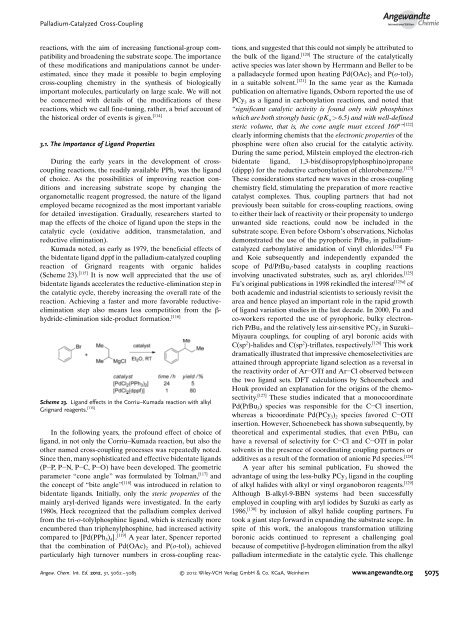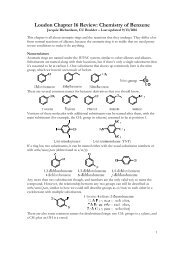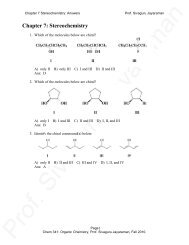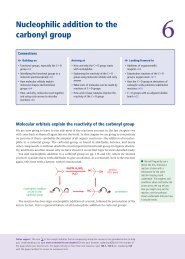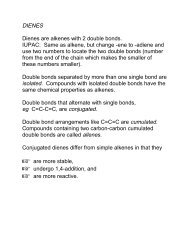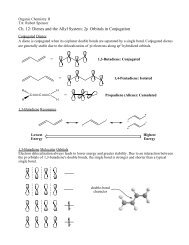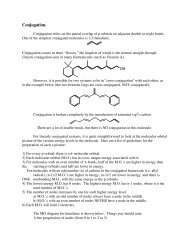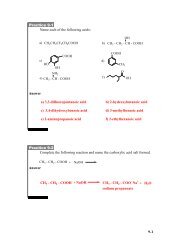Palladium-Catalyzed Cross-Coupling - A Historical Contextual Perspective to the 2010 Nobel Prize
Palladium-Catalyzed Cross-Coupling - A Historical Contextual Perspective to the 2010 Nobel Prize
Palladium-Catalyzed Cross-Coupling - A Historical Contextual Perspective to the 2010 Nobel Prize
Create successful ePaper yourself
Turn your PDF publications into a flip-book with our unique Google optimized e-Paper software.
<strong>Palladium</strong>-<strong>Catalyzed</strong> <strong>Cross</strong>-<strong>Coupling</strong>AngewandteChemiereactions, with <strong>the</strong> aim of increasing functional-group compatibilityand broadening <strong>the</strong> substrate scope. The importanceof <strong>the</strong>se modifications and manipulations cannot be underestimated,since <strong>the</strong>y made it possible <strong>to</strong> begin employingcross-coupling chemistry in <strong>the</strong> syn<strong>the</strong>sis of biologicallyimportant molecules, particularly on large scale. We will notbe concerned with details of <strong>the</strong> modifications of <strong>the</strong>sereactions, which we call fine-tuning, ra<strong>the</strong>r, a brief account of<strong>the</strong> his<strong>to</strong>rical order of events is given. [114]3.1. The Importance of Ligand PropertiesDuring <strong>the</strong> early years in <strong>the</strong> development of crosscouplingreactions, <strong>the</strong> readily available PPh 3 was <strong>the</strong> ligandof choice. As <strong>the</strong> possibilities of improving reaction conditionsand increasing substrate scope by changing <strong>the</strong>organometallic reagent progressed, <strong>the</strong> nature of <strong>the</strong> ligandemployed became recognized as <strong>the</strong> most important variablefor detailed investigation. Gradually, researchers started <strong>to</strong>map <strong>the</strong> effects of <strong>the</strong> choice of ligand upon <strong>the</strong> steps in <strong>the</strong>catalytic cycle (oxidative addition, transmetalation, andreductive elimination).Kumada noted, as early as 1979, <strong>the</strong> beneficial effects of<strong>the</strong> bidentate ligand dppf in <strong>the</strong> palladium-catalyzed couplingreaction of Grignard reagents with organic halides(Scheme 23). [115] It is now well appreciated that <strong>the</strong> use ofbidentate ligands accelerates <strong>the</strong> reductive-elimination step in<strong>the</strong> catalytic cycle, <strong>the</strong>reby increasing <strong>the</strong> overall rate of <strong>the</strong>reaction. Achieving a faster and more favorable reductiveeliminationstep also means less competition from <strong>the</strong> b-hydride-elimination side-product formation. [116]Scheme 23. Ligand effects in <strong>the</strong> Corriu–Kumada reaction with alkylGrignard reagents. [115]In <strong>the</strong> following years, <strong>the</strong> profound effect of choice ofligand, in not only <strong>the</strong> Corriu–Kumada reaction, but also <strong>the</strong>o<strong>the</strong>r named cross-coupling processes was repeatedly noted.Since <strong>the</strong>n, many sophisticated and effective bidentate ligands(P P, P N, P C, P O) have been developed. The geometricparameter “cone angle” was formulated by Tolman, [117] and<strong>the</strong> concept of “bite angle” [118] was introduced in relation <strong>to</strong>bidentate ligands. Initially, only <strong>the</strong> steric properties of <strong>the</strong>mainly aryl-derived ligands were investigated. In <strong>the</strong> early1980s, Heck recognized that <strong>the</strong> palladium complex derivedfrom <strong>the</strong> tri-o-<strong>to</strong>lylphosphine ligand, which is sterically moreencumbered than triphenylphosphine, had increased activitycompared <strong>to</strong> [Pd(PPh 3 ) 4 ]. [119] A year later, Spencer reportedthat <strong>the</strong> combination of Pd(OAc) 2 and P(o-<strong>to</strong>l) 3 achievedparticularly high turnover numbers in cross-coupling reactions,and suggested that this could not simply be attributed <strong>to</strong><strong>the</strong> bulk of <strong>the</strong> ligand. [120] The structure of <strong>the</strong> catalyticallyactive species was later shown by Herrmann and Beller <strong>to</strong> bea palladacycle formed upon heating Pd(OAc) 2 and P(o-<strong>to</strong>l) 3in a suitable solvent. [121] In <strong>the</strong> same year as <strong>the</strong> Kumadapublication on alternative ligands, Osborn reported <strong>the</strong> use ofPCy 3 as a ligand in carbonylation reactions, and noted that“significant catalytic activity is found only with phosphineswhich are both strongly basic (pK a > 6.5) and with well-definedsteric volume, that is, <strong>the</strong> cone angle must exceed 1608” [122]clearly informing chemists that <strong>the</strong> electronic properties of <strong>the</strong>phosphine were often also crucial for <strong>the</strong> catalytic activity.During <strong>the</strong> same period, Milstein employed <strong>the</strong> electron-richbidentate ligand, 1,3-bis(diisopropylphosphino)propane(dippp) for <strong>the</strong> reductive carbonylation of chlorobenzene. [123]These considerations started new waves in <strong>the</strong> cross-couplingchemistry field, stimulating <strong>the</strong> preparation of more reactivecatalyst complexes. Thus, coupling partners that had notpreviously been suitable for cross-coupling reactions, owing<strong>to</strong> ei<strong>the</strong>r <strong>the</strong>ir lack of reactivity or <strong>the</strong>ir propensity <strong>to</strong> undergounwanted side reactions, could now be included in <strong>the</strong>substrate scope. Even before Osborns observations, Nicholasdemonstrated <strong>the</strong> use of <strong>the</strong> pyrophoric PtBu 3 in palladiumcatalyzedcarbonylative amidation of vinyl chlorides. [124] Fuand Koie subsequently and independently expanded <strong>the</strong>scope of Pd/PtBu 3 -based catalysts in coupling reactionsinvolving unactivated substrates, such as, aryl chlorides. [125]Fus original publications in 1998 rekindled <strong>the</strong> interest [125a] ofboth academic and industrial scientists <strong>to</strong> seriously revisit <strong>the</strong>area and hence played an important role in <strong>the</strong> rapid growthof ligand variation studies in <strong>the</strong> last decade. In 2000, Fu andco-workers reported <strong>the</strong> use of pyrophoric, bulky electronrichPtBu 3 and <strong>the</strong> relatively less air-sensitive PCy 3 in Suzuki–Miyaura couplings, for coupling of aryl boronic acids withC(sp 2 )-halides and C(sp 2 )-triflates, respectively. [126] This workdramatically illustrated that impressive chemoselectivities areattained through appropriate ligand selection as a reversal in<strong>the</strong> reactivity order of Ar OTf and Ar Cl observed between<strong>the</strong> two ligand sets. DFT calculations by Schoenebeck andHouk provided an explanation for <strong>the</strong> origins of <strong>the</strong> chemosectivity.[127] These studies indicated that a monocoordinatePd(PtBu 3 ) species was responsible for <strong>the</strong> C Cl insertion,whereas a bicoordinate Pd(PCy 3 ) 2 species favored C OTfinsertion. However, Schoenebeck has shown subsequently, by<strong>the</strong>oretical and experimental studies, that even PtBu 3 canhave a reversal of selectivity for C Cl and C OTf in polarsolvents in <strong>the</strong> presence of coordinating coupling partners oradditives as a result of <strong>the</strong> formation of anionic Pd species. [128]A year after his seminal publication, Fu showed <strong>the</strong>advantage of using <strong>the</strong> less-bulky PCy 3 ligand in <strong>the</strong> couplingof alkyl halides with alkyl or vinyl organoboron reagents. [129]Although B-alkyl-9-BBN systems had been successfullyemployed in coupling with aryl iodides by Suzuki as early as1986, [130] by inclusion of alkyl halide coupling partners, Fu<strong>to</strong>ok a giant step forward in expanding <strong>the</strong> substrate scope. Inspite of this work, <strong>the</strong> analogous transformation utilizingboronic acids continued <strong>to</strong> represent a challenging goalbecause of competitive b-hydrogen elimination from <strong>the</strong> alkylpalladium intermediate in <strong>the</strong> catalytic cycle. This challengeAngew. Chem. Int. Ed. 2012, 51, 5062 – 5085 2012 Wiley-VCH Verlag GmbH & Co. KGaA, Weinheim www.angewandte.org5075


